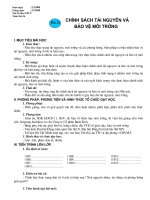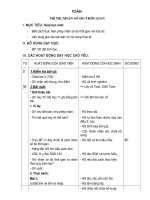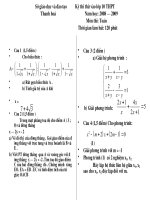Tài liệu Lecture 26: Switching pdf
Bạn đang xem bản rút gọn của tài liệu. Xem và tải ngay bản đầy đủ của tài liệu tại đây (50.06 KB, 7 trang )
CSN200 Introduction to Telecommunications, Winter 2000 Lecture_26 Switching
Switching:
(Ref: Ch-9 of your Text book)
Three different switching techniques are used inside the telephone system:
1. Circuit switching
2. Message switching (using store-and-forward network).
2.1. Packet switching
3. Virtual circuit switching - a compromise between circuit switching and packet
switching. The actual service offered is connection oriented,
but it is implemented internally with packet switching.
Circuit switching:
In circuit switching, a physical connection established by the switching mechanism.
Once a call has been set up, a dedicated path between both ends exists and will continue to
exist until the call is finished.
Fig 2-34, 2-35 Tanenbaum
An important property of circuit switching is the need to set up an end-to-end path before any
data can be sent.
As a result of the established path, there is no danger of congestion, but wastes bandwidth.
Message switching:
In message switching no physical path is established in advance between sender and receiver.
Instead, it is sent and stored in the first switching office (i.e., router) and then forwarded later,
one hop at a time. Each block is received in its entirety, inspected for errors, and then
retransmitted.
Telegrams were message switching.
This technique needs routers with big buffers and also a single block may tie up a router-
router line for minutes, useless for interactive traffic. Packet switching gets round this problem.
Packet switching:
In Packet switching no physical path is established in advance between sender and receiver.
Instead, it is sent to the first switching office (i.e., router) and then forwarded to the next, one
hop at a time. Each block is received in its entirety, inspected for errors, and then
retransmitted. The only difference from the message switching is that, the block size is small,
so no need to store, packets can be buffered in router's main memory instead of on disk.
This limit on the packet size makes sure that no user can monopolize any transmission line for
a long time. And better for interactive traffic compared to message switching.
Lecture26.doc Page 1 (7)
CSN200 Introduction to Telecommunications, Winter 2000 Lecture_26 Switching
The differences between the circuit switching and the packet switching:
Item Circuit switched packet switched
Dedicated copper path Yes No
Bandwidth available Fixed Dynamic
Potentially wasted
bandwidth
Yes No
Store-and-Forward
transmission
No Yes
Each packet follows
the same route
Yes No
Call setup Required Not needed
When can congestion
occur?
At setup time On every packet
Charging Per minute Per packet
The switch hierarchy:
The routing between switches in the current circuit-switched telephone system is done through the five
classes of switching offices.
It can be 5-4-5 (end office - toll office - end office)
It can be 5-4-3-4-5 (end office - toll office - primary office - toll office - end office)
It can be 5-4-3-2-3-4-5 (end office - toll office - primary office - sectional office - primary
office - toll office - end office)
It can be 5-4-3-2-1-2-3-4-5 (end office - toll office - primary office - sectional office - regional
office - sectional office - primary office - toll office - end office)
Fig.4-5, Fitzgerald
Fig.2-37, Tanenbaum
To avoid congestion between busy routes, telephone companies simply install direct trunks.
How switches work inside?
Crossbar switches: (circuit switching)
A crossbar or crosspoint switch is shown in Fig.2-38, Tanenbaum. Here an input and output line may
be connected by a semiconductor switch.
For 1000 lines of inputs and 1000 lines of output we need 1000,000 [= n x n] crosspoints. It is possible
in a VLSI chips but 2000 pins on the chip is not. This is the problem with a crossbar switch is that the
number of crosspoints grows as the square of the number of lines into the switch.
The solution is space division switch.
Lecture26.doc Page 2 (7)
CSN200 Introduction to Telecommunications, Winter 2000 Lecture_26 Switching
A Crossbar switch
Space Division Switch: (circuit switching)
By splitting the crossbar switch into small chunks and interconnecting them, it is possible to build
multistage switches with fewer lines and cross points. These are called space division switches.
A Crossbar switch with fewer lines
A Space Division switch with fewer lines
Fig.2-39, Tanenbaum
In the space division switch with three stages the number of cross points = 2kN + k(N/n)2
For N=1000, n=50 and k=10, we need only 24,000 crosspoints instead of 1000,000 required by a
1000x1000 single stage crossbar.
Stage 2 has a k(N/n) = 10(1000/50) = 200, so a maximum of 200 calls can be connected at once.
The larger k is, the more expensive the switch and the lower the blocking probability. When k = 2n-1,
the switch will never block.
Theoretically a switch with fewer k can block, but in practice it rarely blocks.
Lecture26.doc Page 3 (7)
CSN200 Introduction to Telecommunications, Winter 2000 Lecture_26 Switching
Time Division Switch: (circuit switching)
With time division switching, the n input lines are scanned in sequence to build up an input frame
with n slots. Each slot has k bits.
For T1 switches, the input lines are 24, the slots are 8 bits, with 8000 frames processed per second.
That results the speed of a T1 circuit in 1.5 Mbps [=(24x8+1)x8000 = 193x8000].
Fig.2-40, Tanenbaum
• The heart of the time division switch is the time slot interchanger, which accepts input frames and
produces output frames in which the time slots have been reordered.
In this example, the switch has moved a byte from input line 4 to output line 0, and so on, that is how
the switching happens.
The whole arrangement is a circuit switch, even though there are no physical connections.
• Time division switches use mapping tables that are linear in the number of lines, rather than
quadratic.
Time division switches use RAM buffers to reorder the slots, so the number of lines a switch can
handle is limited by the memory access time, for 100ns it is 625 lines (2nT=125).
It is possible to device multistage switches to overcome the limitations.
ISDN Services: (circuit switching)
The circuit switched telephone system was designed for analog voice transmission and is inadequate
for modern communication needs.
The world's telephone companies got together under the auspices of CCITT and agreed to build a new,
fully digital, circuit-switched telephone system, called ISDN (Integrated Services Digital Network),
goal was to the integration of voice and nonvoice services.
Services:
• Couple of instant call setups,
• Caller's Telephone number, name and address display,
• Call forwarding,
• Call conference
• Electricity meter reading, medical, burglar and smoke alarms.
ISDN System Architecture:
The key idea behind ISDN is that of the digital bit pipe, support multiple independent channels by time
division multiplexing.
Two principal standards for the bit pipe have been developed,
1. A low bandwidth for home use and
2. A higher bandwidth for business use.
Lecture26.doc Page 4 (7)
CSN200 Introduction to Telecommunications, Winter 2000 Lecture_26 Switching
Basic rate: 2B (64kbps digital PCM) + 1D (16kbps digital)
Primary rate: 23B + 1D (US & Japan, to match T1, 1.54Mbps) or
30B + 1D (Europe, to match 2.048Mbps)
Hybrid: 1A (4kHz analog) + 1C (8 or 16kbps digital)
Prospect of ISDN:
The standardization process took years to finalize by this time technology moved fast and made it
obsolete.
Offering 64kbps service to business in the 1980s was a serious proposition, in the 1990s it is a joke.
Many Internet service providers support 144kbps (2B+1D) over a fully digital link.
Broadband ISDN and ATM: (packet switching)
ISDN did not work, so CCITT proposed another standard, the broadband ISDN (B-ISDN), basically a
digital virtual circuit for moving fixed-size packets (cells) at 155 Mbps.
• Broadband ISDN is based on ATM (Asynchronous Transfer Mode) technology.
• ATM is fundamentally a packet-switching technology. In contrast, both the existing PSTN and
narrowband ISDN are circuit-switching technologies.
• B-ISDN can not be sent over existing twisted pair wiring for any substantial distance.
• Space division and time division switches can not be used for packet switching.
• The telephone companies will adopt this technology sooner otherwise some body will, like cable
television companies.
Virtual Circuit: (a compromise between circuit switching and packet switching)
The basic B-ISDN service is a compromise between pure circuit switching and pure packet switching.
The actual service offered is connection oriented, but it is implemented internally with packet
switching.
Two kinds of connections are offered:
1. Permanent virtual circuits - typically remain in place for months or years (always hold table
entries).
2. Switched virtual circuits - set up dynamically as needed like telephone calls (dynamic table
entries).
In a virtual circuit network, like ATM, when a circuit is established, what really happens is that the
route is chosen from source to destination, and all the switches (routers) along the way make table
entries so they can route any packets on that virtual circuit.
Fig.2-43, Tanenbaum
Lecture26.doc Page 5 (7)









